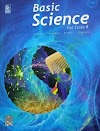Exercise
A. Answer the following in not more than 20 words.
1. Is the light year a unit of time or distance? Define a light year. 2. What is the source of a star's energy?
3. What gives galaxies different shapes? Name a few common shapes of galaxies.
4. What is the Big Dipper?
5. Why are Mercury, Venus, Earth and Mars called terrestrial planets?
6. Name the planets which have rings around them.
7. What is the huge spot on Jupiter?
8. Name two dwarf planets.
9. Write the condition that makes a dwarf planet different from a planet.
B. Answer the following in not more than 40 words.
1. How is a star different from a planet?
2. What is the difference between a galaxy and a constellation?
3. To which constellation does the pattern of stars given below belong? The two stars used by travellers to locate the pole star belong to this constellation. What are these two stars called? Mark them in the diagram.
4. What are asteroids?
5. What are meteorites? In which bodies are meteorite craters more commonly found and why?
6. What is a comet? How is its tail formed?
C. Answer the following in not more than 100 words.
1. What conditions make life possible on earth?
2. Describe how the appearance of the moon changes.
D. Complete the following.
1. The explosion that created the universe is called the .....
2. Scientists recently detected a newborn star 100 light years away. Light from this star takes...... years to reach the earth.
3. The stars seem to move across the sky from...... to........
4. The Milky Way Galaxy is ...... in shape.
5. The sun is able to keep the bodies of the solar system together because of its....
6. The giant planets of our solar system are made up mainly of.......
7. Venus is hotter than Mercury because of the ...... in its atmosphere.
8. Ganymede, the largest moon of the solar system, is even larger than the planet.
Answers
A.
1. A light year is a unit of distance, defined as the distance that light travels in one year in a vacuum.
2. The source of a star's energy is nuclear fusion, which occurs in the star's core.
3. Galaxies have different shapes due to the interplay between gravity, rotation, and collisions. Some common shapes are spiral, elliptical, and irregular.
4. The Big Dipper is a group of seven bright stars in the constellation Ursa Major.
5. Mercury, Venus, Earth and Mars are called terrestrial planets because they have a solid, rocky surface like Earth's.
6. The planets that have rings around them are Saturn, Jupiter, Uranus, and Neptune.
7. The huge spot on Jupiter is the Great Red Spot, which is a giant storm that has been raging for at least 350 years.
8. Two dwarf planets are Pluto and Ceres.
9. The condition that makes a dwarf planet different from a planet is that a dwarf planet has not cleared its orbit of other debris.
B.
1. A star is a luminous sphere of plasma held together by its own gravity, while a planet is a celestial body that orbits a star and does not produce its own light.
2. A galaxy is a vast system of stars, gas, and dust held together by gravity, while a constellation is a group of stars that form a recognizable pattern as seen from Earth.
3. The pattern of stars given below belongs to the constellation Ursa Minor. The two stars used by travellers to locate the pole star are called Dubhe and Merak.
4. Asteroids are small, rocky objects that orbit the Sun, mostly found in the asteroid belt between Mars and Jupiter.
5. Meteorites are rocks from space that survive their passage through Earth's atmosphere and strike the ground. Meteorite craters are more commonly found on the Moon and other planetary bodies with no atmosphere to burn up incoming objects.
6. A comet is a small, icy body that orbits the Sun, with a tail that forms when the heat of the Sun vaporizes its ice and dust. The tail is formed as the vaporized gas and dust are blown away from the comet by the solar wind.
C.
1. Life on Earth is possible due to several factors, including the right distance from the Sun, a stable and suitable atmosphere, the presence of water, and a magnetic field to protect from harmful solar radiation.
2. The appearance of the Moon changes as it orbits the Earth, causing different amounts of sunlight to reflect off its surface. This results in the phases of the Moon, from new moon to full moon and back again.
D.
1. The explosion that created the universe is called the Big Bang.
2. Light from the newborn star detected by scientists takes 100 years to reach the Earth.
3. The stars seem to move across the sky from east to west due to Earth's rotation.
4. The Milky Way Galaxy is spiral in shape.
5. The sun is able to keep the bodies of the solar system together because of its strong gravitational pull.
6. The giant planets of our solar system are made up mainly of hydrogen and helium gases.
7. Venus is hotter than Mercury because of the greenhouse effect in its thick atmosphere, which traps heat from the Sun.
8. Ganymede, the largest moon of the solar system, is even larger than the planet Mercury.
ThankYou










No comments:
Post a Comment